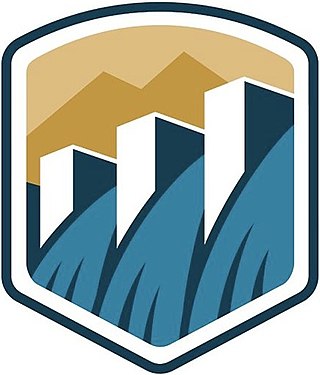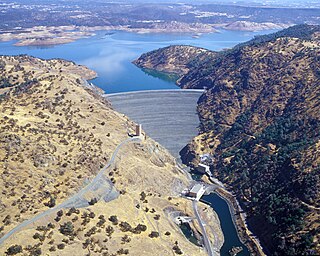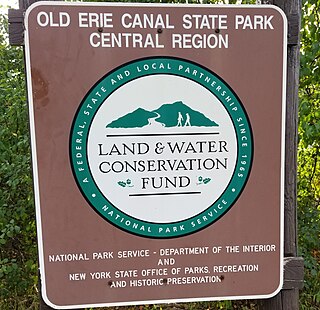
The United States Bureau of Reclamation (USBR), and formerly the United States Reclamation Service, is a federal agency under the U.S. Department of the Interior, which oversees water resource management, specifically as it applies to the oversight and operation of the diversion, delivery, and storage projects that it has built throughout the western United States for irrigation, water supply, and attendant hydroelectric power generation. Currently the USBR is the largest wholesaler of water in the country, bringing water to more than 31 million people, and providing one in five Western farmers with irrigation water for 10 million acres of farmland, which produce 60% of the nation's vegetables and 25% of its fruits and nuts. The USBR is also the second largest producer of hydroelectric power in the western United States.

New Melones Dam is an earth and rock filled embankment dam on the Stanislaus River, about 5 miles (8.0 km) west of Jamestown, California, United States, on the border of Calaveras County and Tuolumne County. The water impounded by the 625-foot (191 m)-tall dam forms New Melones Lake, California's fourth largest reservoir, in the foothills of the Sierra Nevada east of the San Joaquin Valley. The dam serves mainly for irrigation water supply, and also provides hydropower generation, flood control, and recreation benefits.
The California Coastal Conservancy is a state agency in California established in 1976 to enhance coastal resources and access.

The United States' Land and Water Conservation Fund (LWCF) is a federal program that was established by Act of Congress in 1965 to provide funds and matching grants to federal, state and local governments for the acquisition of land and water, and easements on land and water, for the benefit of all Americans. The main emphases of the fund are recreation and the protection of national natural treasures in the forms of parks and protected forest and wildlife areas. The LWCF has a broad-based coalition of support and oversight, including the National Parks Conservation Association, Environment America, The Wilderness Society, the Land Trust Alliance,the Nature Conservancy, and The Conservation Fund.
The Animas-La Plata water project is a water project designed to fulfill the water rights settlement of the Ute Mountain and the Southern Ute tribes of the Ute Nation in Colorado, USA.
The Central Utah Project is a US federal water project that was authorized for construction under the Colorado River Storage Project Act of April 11, 1956, as a participating project. In general, the Central Utah Project develops a portion of Utah's share of the yield of the Colorado River, as set out in the Colorado River Compact of 1922.
The Northern Ute Tribe is one of three ethnically-related Ute Tribes. The Northern Ute Tribe occupies and administers the Uintah and Ouray Indian Reservation in northeastern Utah. The population of the Northern Ute Tribe is approximately 3,500.
In Section 203(a) of the Central Utah Project Completion Act, the United States Congress authorized a federally authorized and funded replacement project to replace the Uinta and Upalco Units of the Central Utah Project (CUP) which were not constructed. The replacement project is the Uinta Basin Replacement Project (UBRP). The UBRP will provide: 2,500 acre feet (3,100,000 m3) of irrigation water; 3,000 acre feet (3,700,000 m3) of municipal and industrial water; reduced wilderness impacts; increased instream flows; and improved recreation. Design work began in 2002. Construction began in 2004 and is anticipated to be completed in 2011. The Central Utah Water Conservancy District is responsible for construction. The United States Department of the Interior oversees funding and compliance with law and environmental regulation.
The Water Resources Development Act of 1986 is part of Pub.L. 99–662, a series of acts enacted by Congress of the United States on November 17, 1986.
The Water Resources Development Act of 1990, Pub.L. 101–640, was enacted by Congress of the United States on November 12, 1990. Most of the provisions of WRDA 1990 are administered by the United States Army Corps of Engineers.
The Water Resources Development Act of 1996 is part of Pub.L. 104–303, was enacted by Congress of the United States on October 12, 1996. Most of the provisions of WRDA 1996 are administered by the United States Army Corps of Engineers.
The Water Resources Development Act of 1992, Pub.L. 102–580, was enacted by Congress of the United States on October 31, 1992. Most of the provisions of WRDA 1992 are administered by the United States Army Corps of Engineers.
The Water Resources Development Act of 1999, Pub.L. 106–53, was enacted by Congress of the United States on August 17, 1999. Most of the provisions of WRDA 1999 are administered by the United States Army Corps of Engineers.
The Water Resources Development Act of 2000, Pub.L. 106–541, was enacted by Congress of the United States on December 11, 2000. Most of the provisions of WRDA 2000 are administered by the United States Army Corps of Engineers.
The Clean Water State Revolving Fund (CWSRF) is a self-perpetuating loan assistance authority for water quality improvement projects in the United States. The fund is administered by the Environmental Protection Agency and state agencies. The CWSRF, which replaced the Clean Water Act Construction Grants program, provides loans for the construction of municipal wastewater facilities and implementation of nonpoint source pollution control and estuary protection projects. Congress established the fund in the Water Quality Act of 1987. Since inception, cumulative assistance has surpassed US$126 Billion, and is continuing to grow through interest earnings, principal repayments, and leveraging.

The Consolidated Natural Resources Act of 2008 was an act passed in the 110th United States Congress and enacted on May 8, 2008.

Conservation Garden Park is located on the grounds of Jordan Valley Water Conservancy District at 8215 South 1300 West, West Jordan, Utah. The project consists of approximately six acres of demonstration gardens and waterwise landscape exhibits and the new Education Center which was completed and opened to the public in summer 2011. The Center is designed to LEED Platinum standards, showcases the best available environmental building technologies, and broadens the theme of the gardens to include conservation of energy and natural resources.

Lake Nighthorse is a reservoir created by the 270 feet (82 m) high Ridges Basin Dam southwest of Durango in La Plata County Colorado. As part of the Animas-La Plata Water Project, Lake Nighthorse provides water storage for tribal and water right claim-holders along the Animas River.
The Colorado Water Conservation Board (CWCB) operates as a division of the Colorado Department of Natural Resources. The Colorado legislature founded the Colorado Water Conservation Board (CWCB) through the passage of House Bill no. 6 in 1937 for the "purpose of aiding in the protection and development of the waters of the state". The bill decreed that the agency would be run by twelve directors, who convened for the first time on July 13, 1997.
Water in Arkansas is an important issue encompassing the conservation, protection, management, distribution and use of the water resource in the state. Arkansas contains a mixture of groundwater and surface water, with a variety of state and federal agencies responsible for the regulation of the water resource. In accordance with agency rules, state, and federal law, the state's water treatment facilities utilize engineering, chemistry, science and technology to treat raw water from the environment to potable water standards and distribute it through water mains to homes, farms, business and industrial customers. Following use, wastewater is collected in collection and conveyance systems, decentralized sewer systems or septic tanks and treated in accordance with regulations at publicly owned treatment works (POTWs) before being discharged to the environment.





